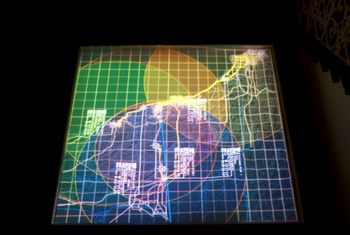Centro Cultural Tijuana- CECUT,
Oct 01, 2008 - Feb 01, 2009
Tijuana, Baja California, Mexico
Proyecto Cívico / Civic Project
by Marcela Quiroz Luna
Even a vacuum is a very subtle kind of body. JEAN-LUC NANCY Proyecto Cívico was one of two exhibitions with which Tijuana inaugurated El Cubo, a building designed to house international shows. Since September 2008, the space has complemented the main body of the Centro Cultural Tijuana (CECUT), which was founded in 1982. Since its creation CECUT has been a cultural lighthouse in Tijuana and Baja California, not only because it is the only cultural institution in the region with facilities, staff and government funding, but also because its very status as "lonely child" has made it diversify its range of activities and audiences. The new building fills a vacuum "deeply felt in the region" for exhibiting "international" art --with all the implications that expression implies-- over and beyond the quality of the artists and the works to be exhibited. Indeed, the sole existence of this Center has led to a very necessary professionalization within the curatorial and museographic field; a criteria set by prospective loaning institutions. For the first time, Tijuana has a facility with the presence and funding needed to commission locally produced art and curatorial projects traveling to the rest of the country and, hopefully, beyond its borders. Will Tijuana be able to live down its almost mythological maquiladora image by generating its own quality work, and what better challenge and opportunity to do so than by shaping substantial cultural projects? It is a relief to be able to say that the first attempt is already on exhibition. Located in select spaces outside the main room on the first of the new building's three floors, the Proyecto Cívico exhibition -co-curated by Lucía Sanromán (Museum of Contemporary Art San Diego, San Diego, CA) and Ruth Estévez (Museo de Arte Carrillo Gil, Mexico City) - provides some glimpses of the show to the ambulatory visitor prior to entering the central galleries. The central entrance to the exhibition is thus accompanied by Nina Waisman's subtle sounds in the work Between Bodies / Entre cuerpos (2008). The sounds captured by Waisman (Utah, USA) on the streets of Tijuana lie in wait, triggered by movement sensors suspended from slim metallic structures in the corridor that leads down to the lobby of the museum. Within the silent memory of the museum, a body walking cautiously between sensors incites Norteño music beats, loudspeakers and sirens. In contrast to the common acceptance of visuality as the initial access to the worlds of pleasure and danger, Waisman awakens and focuses all our attention on our sense of hearing, thus forcing us to redefine the way we relate to, dialogue and negotiation with, our surroundings, the artwork and the body itself. Pressing us to move and listen, Waisman subverts our awareness of a body-among-bodies as she forces us to dodge the delicate sensors that trigger the overhead speakers, changing the clean corridor of El Cubo into a blend of disquieting urban invocations. Before continuing, we should address some preliminary thoughts on the curatorial discourse behind Proyecto Cívico. According to the curatorial text in the catalogue, Estévez and Sanromán state that the idea behind PC is to relate the work of local and foreign artists to the concept of citizenship and its fields of exclusion "whether sought or obliged" linking the discourse to the concept of a "state of exception" put forward by the Italian political thinker, Giorgio Agamben. Perhaps the first thing that raises doubts as to their curatorial approach is whether a "civic project" (with all the possible trends and interpretations such a project entails) can really exist nowadays, particularly in a city like Tijuana. It could therefore be said that the title "Civic Project" must be ironic or that it presents situations that are impossible outside the confines of
|









